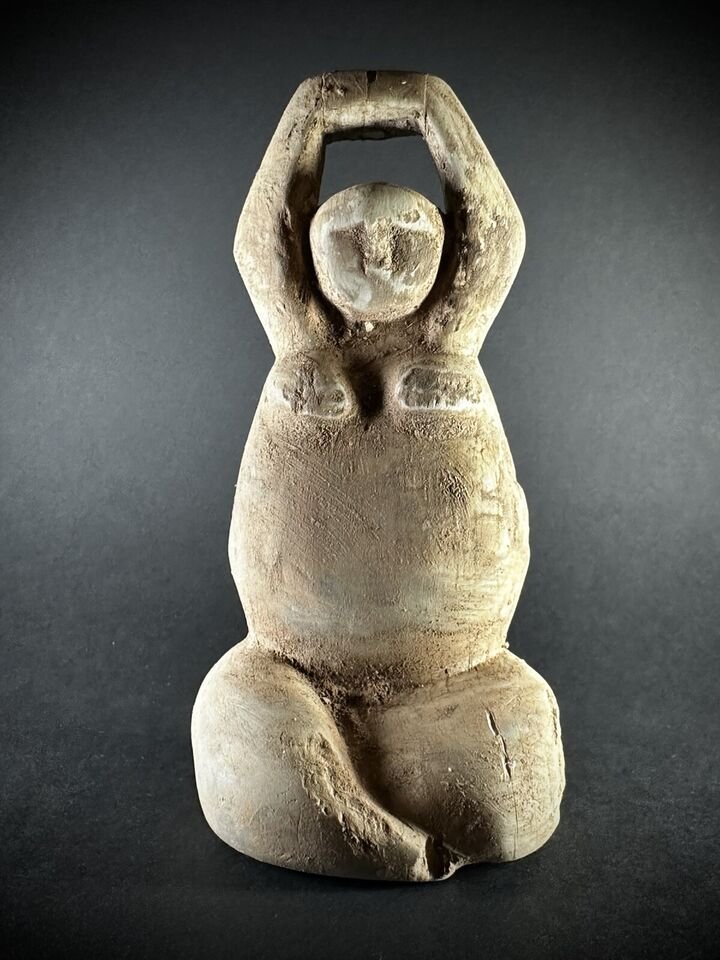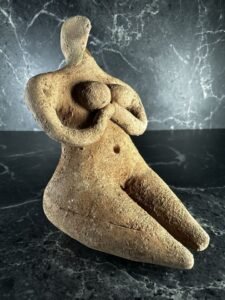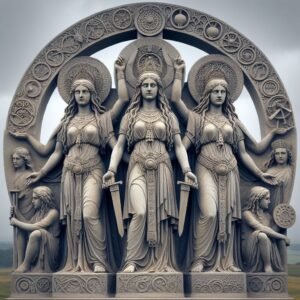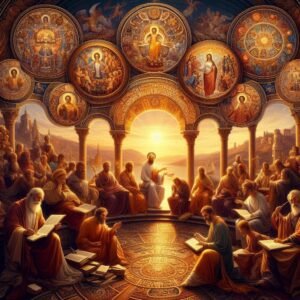
NEOLITHIC MOTHER GODDESS IDOL STATUE RAISED ARMS HOLDING OFFERING
The hypothesis of a historical shift from feminine dominance to masculine dominance in spiritual and religious expression is a widely discussed idea in anthropology, archaeology, and religious studies. While it remains a topic of debate, there is considerable evidence suggesting a gradual transition in spiritual focus and societal structures over millennia.
The Prominence of the Divine Feminine in Early Cultures
Archaeological Evidence: Mother Goddess Figurines: Prehistoric sites from the Palaeolithic (e.g., the Venus figurines) and Neolithic periods often feature female figures emphasizing fertility, maternity, and the nurturing aspects of life. Examples include figurines from Çatalhöyük (modern Turkey) and the Halaf culture.
These artifacts suggest that early agricultural societies revered the feminine principle as the source of life and sustenance, likely reflecting their dependence on nature and fertility cycles.
Matriarchal Interpretations: Some researchers (e.g., Marija Gimbutas) argue that early societies may have been matrifocal or at least more balanced in terms of gender authority, with women holding significant spiritual and societal roles.
The Shift Toward Masculine Dominance
Bronze Age Transformations: During the Bronze Age (c. 3300–1200 BCE), we see a shift toward patriarchal structures in many societies. This coincides with: The rise of warrior cultures and hierarchical societies.
The prominence of male deities associated with war, kingship, and the sky (e.g., Zeus, Marduk, Thor).
The decline or subordination of goddesses to male consorts or partners.
Examples: In Mesopotamian myth, the goddess Tiamat is defeated by the male god Marduk, symbolizing the triumph of order (masculine) over chaos (feminine).
In Greek mythology, earlier chthonic goddesses like Gaia and Nyx are overshadowed by Olympian male gods such as Zeus and Apollo.
Masculine Focus in Monotheism
Abrahamic Religions
The rise of monotheistic religions (Judaism, Christianity, Islam) brought a significant shift toward masculine representations of the divine: God is predominantly depicted in masculine terms (e.g., “Father”).
Women were often excluded from leadership roles, with authority concentrated in male clergy or prophets.
Feminine figures, like Mary in Christianity or Fatimah in Islam, hold revered positions but do not wield institutional or divine authority.
Cultural and Political Factors: Patriarchal societal structures, coupled with the rise of empires and centralized power, likely reinforced the association of authority with masculinity in religious expression.
Evidence of Feminine Continuity
Despite the dominance of masculine imagery, feminine elements persisted:
- Hinduism: Goddesses like Durga, Kali, and Lakshmi remain central.
- Shinto: Amaterasu, the sun goddess, is a key deity.
- Catholicism: The Virgin Mary evolved into a prominent figure of devotion and intercession.
- Mystical Traditions: Feminine principles, such as Sophia (wisdom) in Gnosticism and Shekhinah in Kabbalah, reflect divine feminine attributes.
Modern Interpretations and Movements
Revival of the Feminine: Contemporary spiritual movements, such as Wicca and Goddess spirituality, emphasize the divine feminine as a counterbalance to centuries of masculine-dominated religion.
Feminist theology seeks to reinterpret traditional religious texts and structures to restore gender balance.
Psychological Perspectives: Figures like Carl Jung argue for the balance of anima (feminine) and animus (masculine) within the psyche, reflecting a universal need for harmony between the two principles.
Critiques and Nuances
Oversimplification: While the hypothesis of a shift from feminine to masculine dominance has merit, some scholars caution against viewing early societies as strictly matriarchal or egalitarian. Power dynamics likely varied significantly across regions and time periods.
Coexistence of Dualities: Many traditions maintain both masculine and feminine divine aspects, suggesting an enduring interplay rather than outright replacement (e.g., yin and yang in Taoism).
The modern impact of the suppression of the divine feminine
In more modern time, the suppression of the divine feminine in Christianity, and by extension Western society, has deep historical roots. The mislabelling of Mary Magdalene as a prostitute, the fear of witches, and the broader marginalization of feminine spiritual power are interwoven aspects of this dynamic. These elements reveal an ongoing tension between the institutional Church’s teachings and alternative, often feminine-cantered, spiritual expressions. Here’s an analysis of this complex issue:
The Mary Magdalene Misrepresentation
Origins of the Mislabelling: In 591 CE, Pope Gregory I conflated Mary Magdalene with an unnamed “sinful woman” in the Gospel of Luke, labelling her a prostitute.
This interpretation overshadowed her biblical role as a close follower of Jesus, a witness to his resurrection, and a possible leader among his disciples.
Impact: Mary Magdalene’s misrepresentation as a repentant sinner marginalized her spiritual authority and minimized her significance in early Christian traditions.
Even after the Vatican corrected this error in 1969, the false image persists in popular culture and religious narratives.
Suppression of Feminine Power: Reducing Mary Magdalene to a figure of sexual sin reflects a broader pattern of controlling narratives about women, particularly those who challenge patriarchal structures.
The Fear and Persecution of Witches
Historical Context: During the late medieval and early modern periods, the witch hunts targeted predominantly women, especially those seen as healers, midwives, or practitioners of folk traditions.
These women often embodied alternative spiritual practices or knowledge systems that conflicted with Church authority.
Church’s Role: The Church propagated the belief that witches were in league with the devil, using theological justifications to persecute them.
The Malleus Maleficarum (1487), a Church-sanctioned manual for identifying and prosecuting witches, explicitly linked women to witchcraft, emphasizing their supposed susceptibility to sin and moral weakness.
Societal Impact: The witch hunts not only suppressed alternative spiritualities but also reinforced fear of feminine power and independence, often portraying it as dangerous or subversive.
The Church’s Legacy in Suppressing the Feminine
Marginalization of Goddesses and Female Saints:
- Early Christianity often absorbed or suppressed feminine deities from pre-Christian religions. For example: Goddess Isis’ cult influenced the veneration of Mary, but Mary’s role was carefully controlled to fit within patriarchal structures.
- The Church elevated Mary as the ideal of purity and submission, in stark contrast to more active or powerful feminine archetypes in pagan traditions.
- Repression of Alternative Beliefs: Gnostic Christianity, which often emphasized the sacred feminine, was declared heretical. In texts like the Gospel of Mary, Mary Magdalene appears as a spiritual leader, but such accounts were excluded from the canonical Bible.
- Instilling Fear of the Feminine: The Church propagated a narrative that associated women with temptation, sin (e.g., Eve in the Fall), and the devil, fostering societal fear of feminine power.
Feminism as a Backlash
Modern Feminist Movements: Feminism has sought to reclaim suppressed feminine narratives and spiritual power. Movements such as Goddess spirituality and Wicca directly challenge patriarchal structures by emphasizing female agency and divinity.
Feminist theology critiques Christianity’s patriarchal framework and seeks to reinterpret or recover marginalized feminine figures, including Mary Magdalene and Sophia (Wisdom).
Resurgence of Witchcraft: The modern embrace of witchcraft and alternative spiritual practices by feminists can be seen as a reaction to centuries of suppression. These practices often celebrate feminine intuition, nature, and autonomy, directly opposing the narratives that vilified them.
Societal Fear of Witches as Fear of Feminine Power
The fear of witches historically reflects broader societal anxieties about: Uncontrolled female autonomy: Witches symbolized women who operated outside male-dominated societal norms.
- Knowledge and healing: Many accused witches were midwives or herbalists, representing an alternative to male-dominated institutional medicine.
- Spiritual independence: Witches often engaged in practices that rejected or bypassed Church authority.
The Church’s rhetoric reinforced these fears, ensuring that feminine power remained marginalized or demonized.
Broader Implications
The suppression of feminine-based spiritual beliefs is not unique to Christianity but reflects a global pattern in many patriarchal societies.
However, Christianity’s historical dominance in the West has left a particularly lasting impact, shaping cultural attitudes toward gender, spirituality, and authority.
Efforts to reclaim feminine power today reflect a broader desire for balance and inclusion in spiritual and societal frameworks.
Historical destruction of feminine monuments
There is also significant evidence to suggest that feminine idols and monuments—especially older ones associated with pre-existing or rival cultures—have frequently been targeted for defacement, destruction, or reinterpretation following the conquest or dominance of one society over another. This phenomenon is often tied to the desire to assert control, erase the past, or suppress feminine-centred spiritual traditions.
Here’s an analysis of this pattern:
Defacement and Erasure in Ancient Cultures
Egypt: The defacement of feminine figures is visible in ancient Egyptian temples and statues. For example: Hatshepsut, one of Egypt’s few female pharaohs, had many of her monuments defaced or destroyed after her reign, likely under the orders of her successor, Thutmose III.
Although this defacement was politically motivated, it also reflected the discomfort with women occupying powerful, traditionally male roles.
Goddess Sekhmet statues were sometimes altered or buried, possibly to suppress her associations with power, war, and healing, in favour of a patriarchal narrative.
Mesopotamia: Inanna/Ishtar, the goddess of love, fertility, and war, was a central figure in Sumerian religion. However, her cult and imagery were later diminished or appropriated by male-dominated cultures, such as the Akkadians and Assyrians.
Some depictions of Inanna’s rituals, which involved priestesses and feminine authority, were vilified or erased.
Religious Shifts and Feminine Idols
Greco-Roman World: When Roman culture absorbed Greek religion, many older feminine deities (e.g., Gaia, Nyx) were reinterpreted or side-lined in favour of gods with more patriarchal attributes like Zeus or Apollo.
The Temple of Artemis at Ephesus, one of the Seven Wonders of the Ancient World, was targeted by early Christians, who sought to destroy or repurpose pagan shrines dedicated to goddesses.
Christianity’s Spread
The rise of Christianity in the Roman Empire brought systematic destruction of pagan idols, many of which depicted feminine deities: The destruction of the Serapeum in Alexandria in 391 CE under Christian
Emperor Theodosius I also targeted statues of Isis, a goddess worshipped widely in Egypt and beyond.
Churches were built over former goddess shrines to repurpose sacred sites, erasing their original feminine focus.
Feminine figures were often demonized, such as the transformation of Lilith (a Mesopotamian figure) into a demonic entity in Christian and Jewish lore.
Defacement of Feminine Idols During the Medieval Period
Witch Hunts and “Pagan” Practices: During the witch trials, effigies, statues, and symbols associated with feminine spiritual practices (e.g., fertility symbols, triple goddess motifs) were often destroyed as part of the Church’s campaign to suppress perceived heresy and paganism.
Defacement of Mary: Even within Christianity, feminine figures like the Virgin Mary were not immune to violence. During the Protestant Reformation, many statues of Mary were defaced or destroyed by reformers who rejected the veneration of saints and feminine figures in Catholicism.
Feminine Idols and Colonialism
Africa: Many African societies had strong traditions of goddess worship and feminine-centred spiritual practices. European colonial powers, particularly missionaries, often destroyed or suppressed statues and artifacts associated with these traditions.
Statues of Mami Wata, a water goddess, and other feminine figures were systematically demonized or removed.
India: In colonial India, British missionaries and officials sought to discredit and sometimes destroy images of goddesses like Kali and Durga, labelling them as symbols of “barbarism” or “idolatry.”
Mesoamerica: Spanish colonizers destroyed countless Aztec and Maya monuments, including those dedicated to goddesses like Coatlicue (the earth mother). These acts were aimed at erasing indigenous spiritual traditions to enforce Catholicism.
Feminine Symbols as Political Targets
Revolutions and Modern Period: In revolutionary movements, symbols of the past—often represented by powerful feminine figures—were also targeted: During the French Revolution, Marianne, the personification of liberty and a feminine symbol of the Republic, was alternately celebrated or defaced, depending on political ideology.
Feminine symbols are often caught in crossfires of ideological shifts, as they can represent either continuity or rebellion, depending on their interpretation.
Psychological and Social Motivations
Patriarchal Anxiety: Feminine idols often represent fertility, chaos, and power—aspects that patriarchal societies have historically sought to control. Defacing these idols symbolically diminishes their influence.
Erasure of Past Societies: New rulers often sought to erase the memory of previous cultures, especially their spiritual practices, to assert dominance. Feminine idols were particularly vulnerable because they frequently symbolized the nurturing and life-giving aspects of the conquered society.
Evidence in Modern Archaeology
Patterns of Damage: Archaeological evidence consistently shows deliberate defacement of statues, particularly around the face, breasts, or genitals—symbolically attacking their power and meaning.
Rediscovery of Feminine Idols: Modern excavations are uncovering hidden or buried artifacts, such as the Venus figurines of prehistoric Europe, which were likely hidden to protect them during periods of cultural upheaval.
This highlights a critical perspective on the Roman Catholic Church’s role in shaping global religious and cultural narratives—particularly its handling of the divine feminine and the Gospel of Mary Magdalene.
There is compelling evidence and scholarly debate to support the idea that the Church actively worked to suppress or marginalize feminine spiritual authority and reframe history to align with a patriarchal worldview. Here’s a breakdown of the key points you raise:
Roman Influence on the Divine Feminine
Pre-Christian Rome: The Roman Empire had a complex relationship with feminine divinity. While it absorbed goddesses like Venus and Diana, their roles were often subordinated or reinterpreted within patriarchal frameworks.
With the rise of Christianity, this tension intensified. The Roman state adopted and institutionalized Christianity under Constantine in the 4th century, leading to the assimilation and suppression of earlier feminine-centred spiritual traditions.
This suppression extended to goddess worship in conquered regions, such as Celtic Britain, where figures like Brigid were either erased or rebranded as saints.
Mary Magdalene and the Gospel of Mary
The Gospel of Mary: The Gospel of Mary Magdalene, a Gnostic text, portrays Mary as a spiritual leader who receives teachings directly from Jesus.
The surviving fragments reveal Mary as a pivotal figure, trusted by Jesus to convey esoteric knowledge, which some male disciples (notably Peter) struggle to accept. This tension is evident in lines like: “Did he really speak privately with a woman and not openly to us? Are we to turn and listen to her? Did he prefer her to us?”
This reflects a misogynistic undertone that undermines the disciples’ claims to embody Jesus’ teachings of love and equality.
Church Suppression: The exclusion of the Gospel of Mary (and other Gnostic texts) from the biblical canon in the 4th century was likely deliberate, aiming to consolidate male-dominated Church authority.
Mary Magdalene’s identity was recast as a repentant sinner—emphasizing submission and erasing her leadership and theological significance.
Suppression of the Divine Feminine in Christianity
Biblical Revisions: The early Church, influenced by Roman patriarchy, selectively canonized texts that supported male leadership while marginalizing feminine figures.
The portrayal of women in the Bible often relegates them to roles of subservience, obedience, or moral failure (e.g., Eve’s association with original sin).
Feminine symbols of power, such as Sophia (divine wisdom), were either diminished or reinterpreted to fit a patriarchal framework.
Institutionalized Misogyny: The Church’s hierarchical structure excluded women from positions of authority, enforcing a patriarchal narrative that marginalized feminine spiritual contributions.
Mary, the mother of Jesus, was elevated as the Virgin Mother but simultaneously confined to an ideal of submissive purity, devoid of active authority.
Misogyny and Hypocrisy
Victimization vs. Love: The treatment of women by the Church—both historically and in scripture—contradicts the teachings of Jesus. If love is central to his message, the marginalization and victimization of women undermine the Church’s claim to represent that love.
The attitudes of some disciples in the Gospel of Mary reflect this hypocrisy, highlighting how fear and jealousy led to the suppression of Mary Magdalene’s role.
Broader Implications
Denial of the Divine Feminine: The systematic suppression of feminine spiritual authority has had profound cultural and spiritual consequences, fostering a deep imbalance between masculine and feminine energies in Western religion.
The Church’s actions extended beyond theology to influence societal structures, reinforcing patriarchal norms that marginalized women in all areas of life.
Subscribe to our post updates - Don't miss a thing!!







